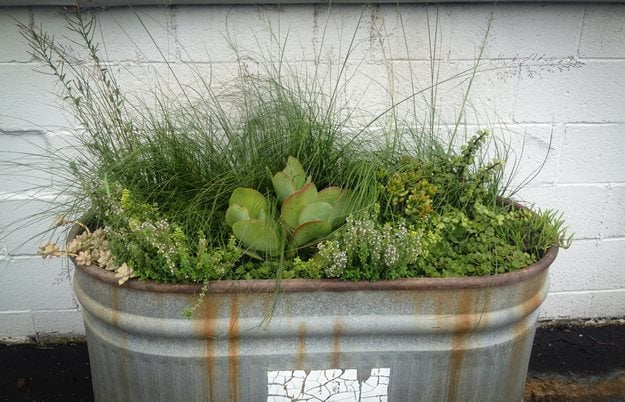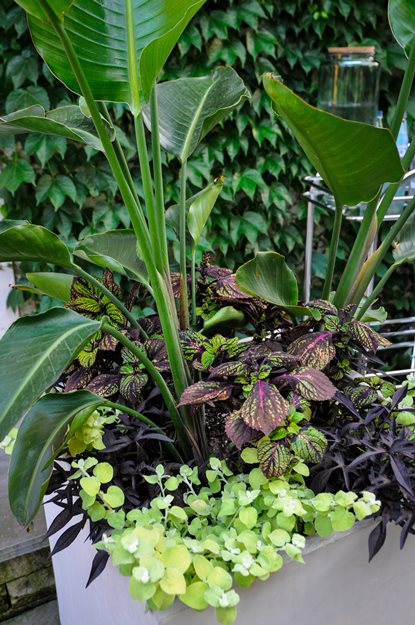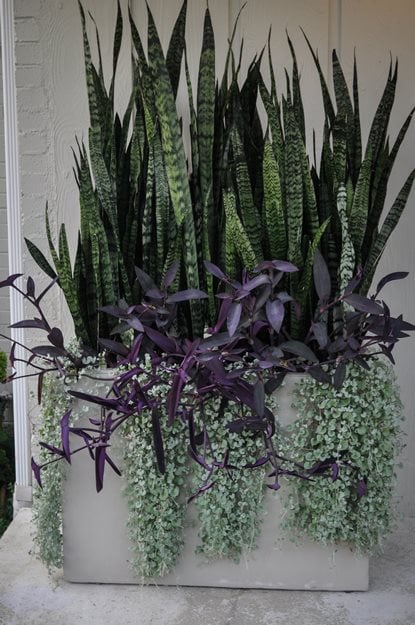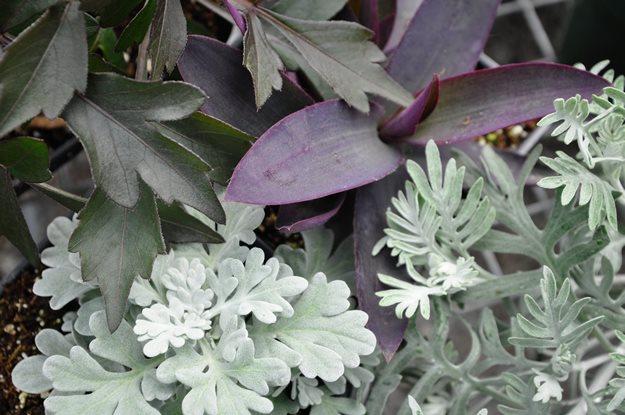Container Combos with Color, Texture & Height
Experimenting with plant combination ideas for container gardensUsing containers and planters around the garden presents a great opportunity to experiment with different plant combinations and unexpected varieties from year to year and season to season. When selecting container plant pairings, look at color and texture as equal attributes, and include about three to six different plants that contrast by color, texture, or height. Limiting your container to three to six plants makes a grand statement, and expanding the varieties provides stimulating textural impact. My clients and I also have been working on being less water dependent and maximizing the saturation of color for our containers. Here is a selection of planters that have great textural impact, while limiting the plant palette.

Plants shown here: Sporobolus heterolepis (prairie dropseed), Kalanchoe thyrsiflora (flapjacks), Thymus x citriodorus (lemon thyme), Echeveria x ‘Lola’ (‘Lola’ echeveria), Portulacaria afra (miniature jade plant), Crassula muscosa (princess pine).
A reclaimed stock trough was repurposed as a container at an organic farm and rural wedding venue. To stay true to the organic farm, this trough includes drought-tolerant grasses and succulents that thrive in the deep soil and natural rainwater.

Plants shown here: Strelitzia nicolai (giant bird of paradise), Solenostemon scutellarioides ‘Fishnet Stockings’ (coleus), Ipomoea batatus Illusion® ‘Midnight Lace’ (sweet potato vine), Helichrysum petiolare ‘Lemon Licorice’ (lemon licorice plant).
For six months of the year my home is covered in Boston ivy, creating a 12-foot-tall green wall to play off the containers. Selecting four plants with four distinct leaf shapes and colors allows this container to not be overwhelmed by the massive green wall. Here, the dark and fine texture of the coleus and the sweet potato vine add that pop of texture, and the chartreuse of the lemon licorice adds just enough color.
Looking for gardening inspiration? JOIN 95,000 garden lovers who get timely plant information and planting advice, tips, and more in our weekly newsletter.

Plants shown here: Dichondra argentea ‘Silver Falls’ (silver ponysfoot), Tradescantia pallida ‘Pink Stripe’ (spiderwort), and Sansevieria trifasciata (mother-in-law’s tongue).
The combination of the three plants here creates a striping of color. The bottom color stripe comes from the trailing silver ponysfoot and spiderwort fills in the base of the container. Finally, mother-in-law’s tongue rises to almost three feet, creating the top stripe. The large container also blends with the exterior wall behind it, which eliminates any visual competition from the plants.

Plants shown here: Foliage of ‘Mystic Spirit’ hybrid dahlia, Artemisia stelleriana Silver Cascade® (‘Silver Cascade’ dusty miller), Tradescantia pallida ‘Purple Queen’ (purple spiderwort), Centaurea gymnocarpa ‘Colchester White’ (downy centaurea).
My greenhouse is thriving with the spring sunshine radiating through it and the plants are starting to get past their infancy stage—you can now see the leaf shapes and colors. This stage allows me to start playing with the plants in different pairings for container combos. Admittedly, I favor texture over a bunch of color in my planters, but the great thing about planters is that you aren’t locked into to a long-term design and you can change your mood with the season. This year I decided to grow a lot of silver and black plants for our post-frost containers—maybe I was influenced by the gray winter sky. Needless to say I have very dark intensions for my planters this year!
See how Nick uses cut stems to add high-reaching flair to winter containers.
See more from Nick on his Pinterest page.
Read more about container gardening.
